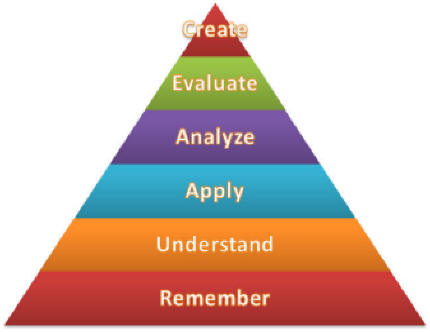Higher Order thinking involves the transformation of information and ideas BLOOM'S TAXONOMY 'Taxonomy' just means 'classification' and Mr. Bloom was the guy who did the classifying.* 
This pyramid represents different levels of learning. | |


 | Higher Order Thinking Skills | | Creating | Generating new ideas, products, or ways of viewing things; combining elements into a new pattern or product (designing, constructing, planning, producing, inventing, composing, devising, generating, modifying, planning, rearranging, reconstructing, revising, rewriting, telling, writing) | | Evaluating | Justifying a decision or course of action; judging or deciding according to a set of criteria (checking, hypothesizing, critiquing, experimenting, judging, appraising, comparing, concluding, criticizing, defending, supporting, relating) | | Analyzing | Breaking information into parts to explore understandings and relationships; breaking down or examining information (comparing, organizing, interrogating, finding, deconstructing, contrasting, diagramming, differentiating, discriminating, illustrating, inferring, separating, distinguishing) | | Applying | Using information in another familiar situation; applying knowledge to new situations (implementing, carrying out, using, executing, changing, demonstrating, calculating, discovering, manipulating, modifying, operating, preparing, producing, relating, showing, solving) | | Understanding | Explaining ideas or concepts; understanding and interpreting meaning (interpreting, summarizing, paraphrasing, classifying, explaining, comprehending, converting, defending, distinguishing, estimating, generalizing, predicting, rewriting, translating) | | Remembering | Recalling information; memorizing and recalling facts (recognizing, listing, describing, retrieving, naming, finding, defining, identifying, knowing, labeling, matching, selecting) | | | Lower Order Thinking Skills |
Interactive example of the levels *Bloom originally categorized "Evaluation" as the top of the pyramid and "Synthesis" as #2. A former student of Bloom's (Lorin Anderson) revised the order on the mid-nineties to what you see above. The new version is referred to as "Bloom's Revised Taxonomy." |